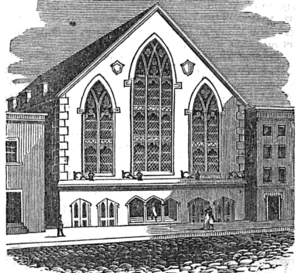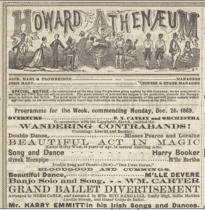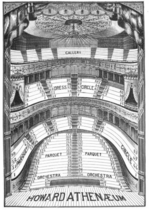Howard Athenaeum facts for kids
The Howard Athenæum (1845–1953), also known as Old Howard Theatre, in Boston, Massachusetts, was one of the most famous theaters in Boston history. Founded in 1845, it remained an institution of culture and learning for most of its years, finally closing in 1953. It was demolished in 1962 after a fire in June 1961.
Contents
History
Of all the theaters founded in Boston, the Howard Athenæum was one of the most famous as well as the most lamented. Popular throughout New England, the theater was affectionately called "The Old Howard." Built in 1843 as a church by the Millerite sect, the flimsy tent-like structure housed a small but loyal congregation who eventually abandoned the site following disappointment with the minister's promise that the world would end in 1844. After Armageddon failed to materialize, the founder of the sect, William Miller, an ex-Deputy Sheriff from Poultney, Vermont, was discredited and the Millerites moved on. The temple was then rebuilt as a playhouse in 1845, only to burn to the ground a few months later. In 1846 a new structure was designed by Isaiah Rogers in a Gothic-like style that was unique among American theaters. The new building, made of Quincy granite and capable of seating 1,360 patrons, was rushed to completion with the aid of funds from a local brewery. It reopened October 5, 1846, at 34 Howard Street in Scollay Square, the area that is now occupied by Boston's Government Center.
For the first several decades of its existence, it successfully vied with the Boston Museum as that city's leading playhouse. While the Boston Museum relied heavily on its great stock company, the Howard became the home of leading touring actors. In an 1860 playbill, the Howard Athenaeum proudly announced that it hosted performances of "opera, tragedy, comedy, burlesque, vaudeville, minstrels, and magicians." Among the great names regularly appearing at the Howard were Edwin Booth, Charlotte Cushman and other stellar performers of that era, including a young John Wilkes Booth, who played Hamlet. The playhouse soon became famous for its opera productions: Verdi's Ernani, which had its American premier at the Howard in 1847, may have been Boston's first exposure to Italian bel canto opera. A program for the Ernani performance at the Howard is owned by the Boston Athenæum, which has a very small but interesting collection of programs from the Howard's early years dating from 1847 to 1848.
On opening night, the Boston Courier for October 13, 1845, had this to say:
"The Howard Athenaeum, a new candidate for patronage of the public, will be open tonight with a capital bill. The old tabernacle has been transformed into a very convenient and handsome theatre and it would sadly puzzle a Millerite to imagine himself at home in its now tasteful interior. Of the company, we can better speak after having seen one of their performances but the names of several old favorites warrant us in expecting good things. That the house will be crowded tonight to the utmost strength of its capacity may be considered certain."
Ballet, opera and serious drama would be the main fare at the Howard for the next twenty years and, on that first night, the Howard Athenaeum opened with a production of Richard Brinsley Sheridan's The School for Scandal. For the first four months of its life, the Howard seemed to enjoy a blessed existence, until on February 25, 1846, during a performance of Pizzaro, a ball of fire representing the sun set the scenery on fire and the building burned to the ground. However, the theatre reopened on October 5, 1846 with Richard Sheridan's The Rivals.
Milestones
During its early period, the Howard Athenaeum played host to many performing superstars, among them was the eminent comedian William Warren, who was for years considered the top comedian in the nation. Scandal also surfaced when, on May 4, 1853, the Howard Athenaeum found itself under unfavorable national scrutiny. Sarah Parker Remond, a black anti-slavery activist and lecturer with the American Anti-Slavery Society (and later a medical doctor), had bought a ticket through the mail for the Donizetti opera, Don Pasquale, but, upon arriving, refused to sit in a segregated section for the show. She was forcibly removed and pushed down a flight of stairs. She eventually won a desegregation lawsuit against the managers of the Howard Athenaeum and received $500 in a settlement.
By the late 1860s, however, the theater had lost much of its audience to its more popular rivals the Boston Museum and the Boston Theatre and had begun presenting variety shows. In 1869, The Howard Athenaeum introduced an era of vaudeville with "Lydia Thomson and Her British Blondes.", By the end of the 19th century, the theatre had completely switched over to burlesque with performers such as Ann Corio, Sally Rand, Gypsy Rose Lee, and comedians including Fanny Brice, and Sophie Tucker, and "Tillie the Tassel."
In 1953, the city tore the building down. A sign from The Old Howard is preserved today in the Emerson Umbrella in Concord, MA.
Chronology of performances and events at the Howard Athenaeum
| Dates | Event | Notables | Of Interest |
|---|---|---|---|
| October 13, 1845 | The School for Scandal | Written by Richard Sheridan | Opening Night – Sell Out Crowd |
| February 25, 1846 | Pizarro | Fire burned down theater | |
| 1847 | Verdi's Ernani | American Premier of Verdi's Ernani | |
| April 28, 1847 | Linda de Chamounix | A lyrical drama in three acts | American Premier of Linda de Chamounix |
| May 1, 1847 | Norma: A Grand Lyrical Tragedy | Written by Bellini | Performed by the Italian Opera Company |
| 1850 | MacBeth | Charlotte Cushman as Lady MacBeth | |
| 1853 | Don Pasquale Opera | Sara Parker Remond lawsuit | |
| December 1, 1853 | Cymbeline | Mrs. T.S. Hamblin, Actress | - |
| 1857 | The Rights of Man | Written by Oliver S. Leland | |
| 1860 | Pilot of Brest | Play | |
| May 4, 1860 | The Romance of a Poor Young Man | Mrs. William H. Smith, Actress | |
| 1861 | Richelieu | Charles Barron, Actor | |
| July 15, 1862 | Adah Isaacs Menken | Dancer | |
| December 8, 1862 | Leah, the Forsaken | Charles Barron, Actor | Augustin Daly's adaptation of "Deborah" |
| March 1, 1880 | Uncle Tom's Cabin | Written by Harriet Beecher Stowe | |
| March 21, 1881 | Gifford's Luck | Written by Charles Hoyt | A tragic melodrama |
| January 9, 1886 | Two John's | ||
| January 1, 1894 | Olio: The Kouta-Kouta Dancers | Directed by Mme. Carre | |
| December 3, 1951 | Georgia Sothern | Burlesque |
Actors and actresses who began their careers at the Howard Athenaeum
Fanny Davenport (April 10, 1850 – September 26, 1898) was an American stage actress. The daughter of Edward Loomis Davenport and Fanny Vining, she was born in London, England, but was brought to America when a child and educated in the Boston public schools. When seven years old she appeared at the Howard Athenæum in Boston, as the child of Metamora.
Barney Fagan (January 12, 1850 – January 12, 1937) made his first professional appearance in his native city of Boston at the famous Howard Athenaeum in 1860, as the Cabin Boy in the "Pilot of Brest." He remained at this theatre several seasons until 1865 when he played his first minstrel engagement with the Morris Brothers in Boston. In 1870 Mr. Fagan went to St. Johns, New Brunswick, Canada, and appeared with Pete Lee’s Minstrels. In 1873 he joined Buckley’s Serenaders in Boston, and took a fellow dancer, Joe Parks, as a partner. During the period 1873–1876, Fagan and Parks, known as the American Lads, played variety engagements. In 1876 he did the famous Heifer dance with Richard Golden in Evangeline. Mr. Fagan next joined John Fenton in a dancing specialty, and continued with him until 1878, when he formed a partnership with Lizzie Mulvey, which lasted one season.
Nathaniel Carl Goodwin (July 25, 1857 – January 31, 1919) was an American actor and vaudevillian born in Boston. While clerk in a large shop he studied for the stage and made his first appearance in 1874 at the Howard Athenaeum in Boston in Stuart Robson's company as the newsboy in Joseph Bradford's Law in New York. The next year he appeared at Tony Pastor's Opera House in New York City where he began his career as a vaudevillian.
William Edward Sheridan (June 1, 1839 – May 18, 1887), born in Boston, where he made his debut at the Howard Athenaeum in 1858, he became a leading portrayer of villains and tragic figures in Cincinnati until the outbreak of the Civil War. After the war, despite a badly injured arm, he continued to be an important actor, his notable roles including Othello, Shylock, and Sir Giles Overreach. Sheridan also was the first American Beamish McCloud in Arrah na Pogue (1865). Following a long San Francisco engagement, he left for a tour of Australia, where he died. Otis Skinner remembered the virile actor with dark, deep set eyes as a man of splendid power, with one of the most intriguing voices I ever listened to. Others remarked on his voice's striking resonance.
Denman Thompson (October 15, 1833 – April 14, 1911) For three generations his ancestors had been born and lived in Swanzey New Hampshire. In 1847 when he was fourteen years old, he returned with his family to Swanzey, New Hampshire, the town which became the inspiration for writing his famous play, "The Old Homestead." While living there in Swanzey, Denman attended the Mount Caesar Seminary (now the Mount Caesar Union Library). His first appearance on the stage was at the Howard Athenaeum, Boston (1850) where he acted as a "supe" for Charlotte Cushman in "Lady Macbeth."
Image gallery







